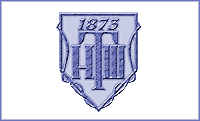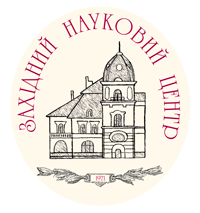Galyna NYCHYPORUK, Davyd DYMYTRYADI, Vasyl ZAREMBA, Oleg DELENKO, Yaroslav KALYCHAK
Ivan Franko National University of Lviv, Kyryla i Mefodiya Str., 6, 79005 Lviv, Ukraine e-mail: yaroslav.kalychak@lnu.edu.ua
DOI: https://doi.org/10.37827/ntsh.chem.2025.78.194
THE SYSTEM Tb–Co–In: PHASE EQUILIBRIA AND CRYSTAL STRUCTURE OF THE COMPOUNDS
Interaction between the components in the Tb–Co–In system was investigated by X-ray powder diffraction and, partially, scanning electron microscopy with energy-dispersive X-ray spectroscopy. Isothermal section of the phase diagram was constructed in full concentration range at 870 K. The samples were synthesized in an arc-furnace on a water-cooled Cu-plate under an argon atmosphere and annealed in silica tubes at 870 K for two months. The phase analysis was performed by X-ray powder diffraction method. Microstructures of polished samples and quantitative and qualitative analysis were carried out on a Tescan Vega 3 LMU scanning electron microscope equipped with an Oxford Instruments SDD X-MaxN20 detector. Existence of eight ternary compounds, namely TbCoIn5 (HoCoGa5-type structure), Tb2CoIn8 (Ho2CoGa8-type structure), TbCo2In (PrCo2Ga-type structure), Tb10Co3In10 (Tb10Co3In10-type structure), Tb11Co4In9 (Nd11Pd4In9-type structure), Tb23Co6,7In20,3 (Er23Co6.7In20.3-type structure), Tb6Co2.14In0.86 (Ho6Co2Ga-type structure), Tb14Co3In3 (Lu14Co3In3-type structure) has been confirmed and three compounds have been discovered in the Tb–Co–In system at the temperature of investigation. The crystal structure of Tb26Co6In11 compound was refined using X-ray powder data (STOE STADI P, Cu Kα1 radiation). It belongs to Sm26Co11Ga6 structure type (space group P4/mbm, tP86, a = 11.893(6); c = 15.824(8) Å, Rwp = 0.0552). The crystal structure of the compounds Tb5Co3In2 and TbCo4In remains unknown. The substitution of Tb for In up to 5 at.% was observed for compound TbCo3. Compounds of the Tb–Co–In system with a known crystal structure can be divided into two groups. The first group consists of terbium-rich compounds Tb26Co6In11, Tb6Co2.14In0.86 and Tb14Co3In3. These are complex multilayer structures with large values of cell parameters. Another group of compounds includes double-layer structures in the direction perpendicular to the shortest cell period. It should be noted that the value of shortest cell parameter decreases from ~ 4.5 to ~ 3.6 Å with increasing terbium content. These compounds can be considered as being built from fragments of simpler structures. Compounds TbCoIn5 and Tb2CoIn8 are built from fragments of structural types AuCu3 and PtHg2, compound TbCo2In – from fragments of CsCl- and CaCu5-types, and compounds Tb10Co3In10, Tb11Co4In9, Tb23Co6.7In20.3 – from fragments of CsCl- and AlB2-types.
Keywords: indium, cobalt, terbium, ternary system, isothermal section, ternary compound.
References:
-
1. Canepa F., Napoletano M., Manfrinetti P., Merlo F. Gd6Co2.2In0.8: an intermetallic compound with complex
magnetic behavior. J. Alloys Compd. 2002. Vol. 334. P. 34–39.
( http://doi.org/10.1016/S0925-8388(01)01774-1).
2. Baran S., Tyvanchuk Yu., Szytula A. Crystal structure and magnetic properties of R11Co4In9 (R = Tb, Dy, Ho, Er)
compounds. Intermetallics. 2021. Vol. 130. 107065. http://doi.org/10.1016/j.intermet.2020.107065.
3. Petrovic C., Pagliuso P.G., Hundley M.F., Movshovich R., Sarrao J.L., Thompson J.D., Fisk Z., Monthoux P.
Heavy-fermion superconductivity in CeCoIn5 at 2.3 K. J. Phys.: Condens. Matter. 2001. Vol. 13. P. L337–L342.
https:/doi.org/10.1088/0953-8984/13/17/103.
4. Chen G., Ohara S., Hedo M., Uwatoko Y., Sekamoto I. Transport properties of the heavy-fermion superconductor
Ce2CoIn8. J. Phys.: Condens. Matter. 2003. Vol. 15. P. S2175–S2178. https://doi.org/10.1088/0953-8984/15/28/346.
5. Zaremba V., Dzevenko M., Nychyporuk G., Kalychak Ya. Phase equlibrium in the Y–Ni–In systhem at 870 K. Visnyk
Lviv Univ. Ser. Chem. 2021. Iss. 62. P. 18–27. https:/doi.org/10.30970/vch.6201.018.
6. Nychyporuk G., Dmytrakh O., Kalychak Ya. The systhem La–Ni–In: phase equlibriua and crystal structures of the
compounds. Proc. Shevchenko Sci. Soc. Chem. Sci. 2024. Vol. 75. P. 28–39.
https:/doi.org/10.37827/ntsh.chem.2024.75.028.
7. Kalychak Ya. The component interaction in Ce–Ni–In system. Ukr. Chem. Journ. 1998. Vol. 64(7). P. 15–20.
8. Zaremba V., Dzevenko M., Pöttgen R., Kalychak Ya. Phase equilibrium in the Gd–Ni–In system at T = 870 K. Z.
Naturforsch. B. 2019. Vol. 74(7–8). P. 613–618. https://doi.org/10.1515/znb-2019-0083.
9. Dzevenko M., Tyvanchuk Yu., Demidova Ch., Lukachuk M., Kalychak Ya. Phase equilibria in Tb–Ni–In system at 870
K. Visnyk Lviv Univ. Ser. Chem. 2014. Iss. 55(1). P. 21–28.
10. Tyvanchuk Yu. B., Zaremba V. I., Akselrud L. G., Szytula A., Kalychak Ya. M. The Dy–Ni–In system at 870 K:
isothermal section, solid solutions, crystal structures. J. Alloys Compd. 2017. Vol. 704. P. 717–723.
http://dx.doi.org/10.1016/j.jallcom.2017.02.023.
11. Zaremba V., Dzevenko M., Nychyporuk G., Maletska Yu., Kalychak Ya. The system
Ho–Ni–In at 870 K. Visnyk Lviv Univ. Ser. Chem. 2022. Iss. 63. P. 16–28. https:/doi.org/10.30970/vch.6301.016.
12. Dzevenko M., Tyvanchuk Yu., Bratash L., Zaremba V., Havela L., Kalychak Ya. Ternary system Er–Ni–In at T = 870
K. J. Solid State Chem. 2011. Vol. 184(10). P. 2707–2712. https://doi.org/10.1016/j.jssc.2011.08.006.
13. Tyvanchuk Yu. B., Lukachuk M., Pöttgen R., Szytula A., Kalychak Ya. M. The ternary system Tm–Ni–In at 870 K.
Z. Naturforsch. B. 2015. Vol. 70. P. 665–670. https://doi.org/10.1515/znb-2015-0075.
14. Zaremba V., Nychyporuk G., Dzevenko M., Kalychak Ya. Ternary system Lu–Ni–In at T = 870 K. Visnyk Lviv Univ.
Ser. Chem. 2023. Iss. 64. P. 14–25. https:/doi.org/10.30970/vch.6401.014.
15. Kalychak Ya. M., Zaremba V. I., Pöttgen R., Lukachuk M., Hoffmann R.-D. Rare Earth–Transition Metal–Indides.
In: K. A. Gschneidner, Jr., J.-C. Bünzli, V. K. Pecharsky (Eds.). Handbook on the Physics and Chemistry of Rare
Earths. Elsevier, Amsterdam. 2005. Vol. 34. P. 1–133. https://doi.org/10.1016/S0168-1273(04)34001-8.
16. Kalychak Ya. Composition and crystal structure of rare-earth–Co–In compounds. J. Alloys Compd. 1999. Vol. 291.
P. 80–88. https://doi.org/10.1016/S0925-8388(99)00290-X.
17. Gulay N. L., Tyvanchuk Yu. B., Pöttgen R., Kalychak Ya. M. The ternary system Sc–Co–In at 870 K: the
isothermal section and the crystal structures of the compounds. Z. Naturforsch. B. 2022. Vol. 77(10). P. 713–718.
https://doi.org/10.1515/znb-2022-0105.
18. Kalychak Ya.M. The ternary system Ce–Co–In. Visnyk Lviv Univ. Ser. Chem. 1999. Iss. 38. P. 70–73.
19. Gabay A. M., Hadjipanayis G.C. Phases and phase equilibria in cobalt-rich Pr–Co–In alloys for permanent
magnets. J. Alloys Compd. 2010. Vol. 500. P. 161–166. https://doi.org/10.1016/j.jallcom.2010.03.247.
20. Dzevenko M., Hamyk A., Tyvanchuk Yu., Kalychak Ya. Phase equlibria in the Er–Co–In system and crystal
structure of Er8CoIn3 compound. Cent. Eur. J. Chem. 2013. Vol. 11. P. 604–609.
https://doi.org/10.2478/s11532-012-0195-y.
21. Kalychak Ya.M., Zaremba V.I., Pecharskii V.K. Crystal structure of terbium cobalt indium(1/2/1), TbCo2In. Z.
Kristallogr. 1993. Vol. 205. P. 333–334. https://doi.org/10.1524/zkri.1993.205.12.333.
22. Nychyporuk G. P., Dymytryadi D. G., Bednarchuk T. J., Kinzhybalo V. V., Kalychak Ya. M. RE10Co3In10 (RE = Y,
Gd, Tb, Dy, Ho, Er, Tm) – a new intergrowth structure with CsCl- and AlB2-type slabs. Z. Naturforsch. B. 2025.
Vol. 80(6–7). P. 233–242. https://doi.org/10.1515/znb-2025-0018.
23. Tyvanchuk Yu. B., Dzevenko M. V., Kalychak Ya. M. R11Co4In9 (R = Gd, Tb, Dy, Ho, Er) – the first
representatives of Nd11Pd4In9 structure type in R–Co–In systems. Visnyk Lviv Univ. Ser. Chem. 2012. Iss. 53. P.
127–132.
24. Tyvanchuk Yu., Babizhetskyy V., Baran S., Szhytula A., Smetana V., Lee S., Oliynyk A. O., Mudring A.-V. The
crystal and electronic structure of RE23Co6.7In20.3 (RE = Gd–Tm, Lu): a new structure type based on intergrowth of
AlB2- and CsCl-type related slabs. J. Alloys Compd. 2024. Vol. 976. P. 173241(1-12).
https://doi.org/10.1016/j.jallcom.2023.173241.
25. Kalychak Ya.M., Zaremba V.I., Zavalij P.Yu. Crystal structure of holmium cobalt indium (6/2/1) Ho6Co2+xIn1-x
(x = 0.135). Z. Kristallographie. 1993. Vol. 208. P. 380–381. https://doi.org/10.1524/zkri.1993.208.Part-2.380.
26. Zaremba V. I., Kalychak Ya. M., Dzevenko M. V., Rodevald U. C., Heyring B., Pöttgen R. A single crystal study
of Re14Co3In3 (RE = Y, Tb, Dy, Ho, Er). Z. Naturforsch. B. 2006. Vol. 61. P. 23–28.
https://doi.org/10.1515/znb-2006-0105.
27. Schöbel J. D., Stadelmaier H. H. Das Zweistoffsystem Kobalt–Indium. Zeitschrift für Metallkunde. 1970. Vol.
61. P. 342–343.
28. Gulay N. L., Kösters J., Kalychak Ya. M., Matar S. F., Rabenbauer A., Nilges T., Pöttgen R. Peierls distorsion
of the cobalt chain in the low–temperature structure of CoIn2. Z. Kristallogr. Cryst. Mater. 2022. Vol. 237, No.
6–7. P. 239–248. DOI:10.1515/zkri-2022-0020
29. Binary Alloy Phase Diagrams. Ed. by T. B. Massalsky. American Society for Metals. Metal Park. OH 4407. 1986.
Vol. 1–3.
30. Pearson’s Handbook of Crystallographic Data for Intermetallic Phases. Ed. by P. Villars. – ASM International.
Materials Park. OH 44073. 1997. Vol. 1–2.
31. Shtender V. V., Denys R. V., Zavaliy I. Y., Zelinska O. Y., Paul Boncour V., Pavlyuk V. V. Phase equilibria in
the Tb–Mg–Co system at 500°C, crystal structure and hydrogenation properties of selected compounds. J. Solid State
Chem. 2015. Vol. 232. P. 228–235. https://doi.org/10.1016/j.jssc.2015.09.031.
32. Ostertag W., Strnat K. Rare Earth cobalt compounds with the A2B17 structure. Acta Crystallogr. 1966. Vol. 21.
P. 560–565. https://doi.org/10.1107/S0365110X66003451.
33. Adams W., Moreau J. M., Parte E., Schweizer J. R12Co7 compounds with R = Gd, Tb, Dy, Ho, Er. Acta Crystallogr.
B. 1976. Vol. 32. P. 2697–2699. https://doi.org/10.1107/S0567740876008595.
34. Yatsenko S. P., Semyannikov A. A., Shakarov H. O., Fedorova E. G. Phase diagrams of binary rare earth
metal–indium systems. J. Less-Common Met. 1983. Vol. 90. P.95–108. https://doi.org/10.1016/0022-5088(83)90121-2.
35. Galera R. M., Morin P. Occurrence of multiaxial spin structures in the rare earth–indium3 cubic compounds. J.
Magn. Magn. Mater. 1992. Vol. 116. P. 159–168. https://doi.org/10.1016/0304-8853(92)90160-P.
36. Delfino S., Saccone A., Mazzone D., Ferro R. The R3In5 and R3Tl5 phases of the rare earths. J. Less-Common
Met. 1981. Vol. 81. P. 45–53. https://doi.org/10.1016/0022-5088(81)90267-8.
37. Lethuillier P., Percheron-Guegan A. Crystallographic and magnetic properties of the compounds (Gd, Tb, Dy,
Ho)In. J. Less-Common Met. 1976. Vol. 46. P. 85–89. https://doi.org/10.1016/0022-5088(76)90181-8.
38. Baela W., Szytuła A. Crystal structure and magnetic properties of RE2In compounds. J. Less-Common Met.1988.
Vol. 138. P. 123–128. https://doi.org/10.1016/0022-5088(88)90242-1
39. Chen H., Yao J., Garchev A.V., Yapaskurt V.O., Morozkin A.V. Tb–Co–In system at 870 K and magnetic ordering of
Tb2CoIn8, Tb23Co7In20, Tb26Co5In12 and Tb6Co2In. J. Solid State Chemistry. 2025. Vol. 341. 125089.
https://doi.org/10.1016/j.jssc.2024.125089.
40. Kraus W., Nolze G. Powder Cell For Windows. Berlin, 1999.
41. STOE WinXPOW, Version 1.2, STOE & CIE GmbH. Darmstadt, 2001.
42. Rodriguez-Carvajal J. Recent developments of the program FULLPROF. Commission on Powder Diffraction.
Newsletter. 2001. Vol. 26. P. 12–19.
43. Dzevenko M.V., Davydov V.M., Kalychak Ya.M. Crystal structure of the Er1-xCo3Inx (x = 0.07; 0.28). Visn. Odes.
Univ., Ser. Chem. 2004. Vol. 9(6–7). P. 81–85.
44. Gulay N. L., Kösters J., Kai Reimann M., Kalychak Ya.M., Pöttgen R. Lu26T17–xInx (T = Rh, Ir, Pt) – first
indium intermetallics with Sm26Co11Ga6 type structure. Z. Naturforsch. 2022. Vol. 77b. P. 735−741.
https://doi.org/10.1515/znb-2022-0111.
45. Yarmolyuk Y.P., Grin Y., Olesh O.M. Crystal structure of the compounds R26GaxCo17-x
(R = La, Ce, Pr, Nd, or Sm,) and R26GaxNi17-x (R = Ce, Pr, Nd, or Sm). Sov. Phys. Crystallogr. 1980. Vol. 25. P.
143–146.
46. Gladyshevskii R.E., Grin Y., Yarmolyuk Y.P. The crystal structure of R6GaCo2 compounds (R = Y, Tb, Dy, Ho, Er,
Tm, Lu). Dopov. Akad. Nauk Ukr. RSR, Ser. A. 1983. Vol. 2. P. 67–70.
47. Emsley J. The Elements: 2-nd ed. Oxford: ClarendonPress, 1991. 251 p.
48. Nychyporuk G.P., Dymytryadi D. G., Kalychak Ya.M. Synthesis and crystal structure of Tb26Co6.4In10.6 compound.
Physics and chemistry of solids: status, achievements and prospects: materials VIII Scientific and practical
conference, Lutsk, 18-19 October 2024, P. 73.
How to Cite
NYCHYPORUK G., DYMYTRYADI D., ZAREMBA V., DELENKO O., KALYCHAK Ya. THE SYSTEM Tb–Co–In: PHASE EQUILIBRIA AND CRYSTAL STRUCTURE OF THE COMPOUNDS. Proc. Shevchenko Sci. Soc. Chem. Sci. 2025. Vol. 78. P. 194-205.

